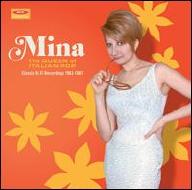Born Anna Maria Mazzini in Busto Arsizio, Lombardy in 1940, she debuted in 1958 at a club called La Bussola, where she caught the attention of Ducale-Italdisc Broadway producer David Matalon. He was impressed with the young singer and soon recorded four songs with her: two in English under the name Baby Gate -- "Be Bop a Lula" and "When" -- and two in Italian as Mina: "Non Partir" and "Malatia." It was the latter name that she stuck with for her debut album, Tintarella di Luna, which was released in 1960.
During the '60s, she recorded over a dozen albums, and -- thanks to her high visibility in the television commercials that began in Italy after WWII and the economic boom that followed -- she became one of the country's most famous stars, notching seven number one albums, including 1971's best-selling Mina and 1976's Singolare y Plurale. At the height of her popularity, Mina announced that she would retire from the spotlight, a public hiatus which she started after the 1978 live album Mina Live '78. Recorded where it all started at La Bussola, the set celebrated the first 20 years of her career.
Withdrawing from the public eye, she continued to record and release albums, which maintained her chart presence through the '80s and '90s. During that era, she issued almost three dozen efforts, seven of which topped the Italian charts, including Si, Buana (1986), Lochness (1993), Leggera (1997), and Olio (1999). In addition to her fresh output, Mina began releasing greatest-hits collections, including 2004's chart-topping, triple-disc The Platinum Collection, which introduced her to a new generation of fans. The following year, she issued Bula Bula, another number one that incorporated sleek pop production and dance beats. Even into her seventies, Mina showed no signs of slowing down, notching another pair of chart-toppers with Le Migliori (2016) and Maeba (2018). In 2019, she joined fellow pop vocalist Ivano Fossati for a duets album, Mina Fossati. ~ Neil Z. Yeung, Rovi

















